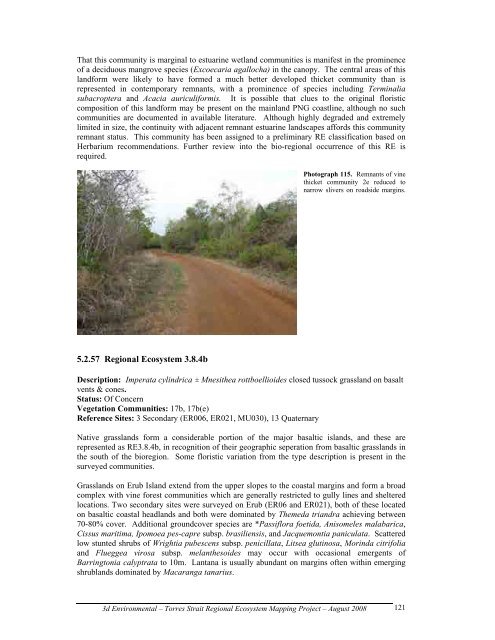Appendix 2 - Vegetation Communities and Regional Ecosystems
Appendix 2 - Vegetation Communities and Regional Ecosystems
Appendix 2 - Vegetation Communities and Regional Ecosystems
Create successful ePaper yourself
Turn your PDF publications into a flip-book with our unique Google optimized e-Paper software.
That this community is marginal to estuarine wetl<strong>and</strong> communities is manifest in the prominence<br />
of a deciduous mangrove species (Excoecaria agallocha) in the canopy. The central areas of this<br />
l<strong>and</strong>form were likely to have formed a much better developed thicket community than is<br />
represented in contemporary remnants, with a prominence of species including Terminalia<br />
subacroptera <strong>and</strong> Acacia auriculiformis. It is possible that clues to the original floristic<br />
composition of this l<strong>and</strong>form may be present on the mainl<strong>and</strong> PNG coastline, although no such<br />
communities are documented in available literature. Although highly degraded <strong>and</strong> extremely<br />
limited in size, the continuity with adjacent remnant estuarine l<strong>and</strong>scapes affords this community<br />
remnant status. This community has been assigned to a preliminary RE classification based on<br />
Herbarium recommendations. Further review into the bio-regional occurrence of this RE is<br />
required.<br />
5.2.57 <strong>Regional</strong> Ecosystem 3.8.4b<br />
Photograph 115. Remnants of vine<br />
thicket community 2e reduced to<br />
narrow slivers on roadside margins.<br />
Description: Imperata cylindrica ± Mnesithea rottboellioides closed tussock grassl<strong>and</strong> on basalt<br />
vents & cones.<br />
Status: Of Concern<br />
<strong>Vegetation</strong> <strong>Communities</strong>: 17b, 17b(e)<br />
Reference Sites: 3 Secondary (ER006, ER021, MU030), 13 Quaternary<br />
Native grassl<strong>and</strong>s form a considerable portion of the major basaltic isl<strong>and</strong>s, <strong>and</strong> these are<br />
represented as RE3.8.4b, in recognition of their geographic seperation from basaltic grassl<strong>and</strong>s in<br />
the south of the bioregion. Some floristic variation from the type description is present in the<br />
surveyed communities.<br />
Grassl<strong>and</strong>s on Erub Isl<strong>and</strong> extend from the upper slopes to the coastal margins <strong>and</strong> form a broad<br />
complex with vine forest communities which are generally restricted to gully lines <strong>and</strong> sheltered<br />
locations. Two secondary sites were surveyed on Erub (ER06 <strong>and</strong> ER021), both of these located<br />
on basaltic coastal headl<strong>and</strong>s <strong>and</strong> both were dominated by Themeda tri<strong>and</strong>ra achieving between<br />
70-80% cover. Additional groundcover species are *Passiflora foetida, Anisomeles malabarica,<br />
Cissus maritima, Ipomoea pes-capre subsp. brasiliensis, <strong>and</strong> Jacquemontia paniculata. Scattered<br />
low stunted shrubs of Wrightia pubescens subsp. penicillata, Litsea glutinosa, Morinda citrifolia<br />
<strong>and</strong> Flueggea virosa subsp. melanthesoides may occur with occasional emergents of<br />
Barringtonia calyptrata to 10m. Lantana is usually abundant on margins often within emerging<br />
shrubl<strong>and</strong>s dominated by Macaranga tanarius.<br />
3d Environmental – Torres Strait <strong>Regional</strong> Ecosystem Mapping Project – August 2008<br />
121


